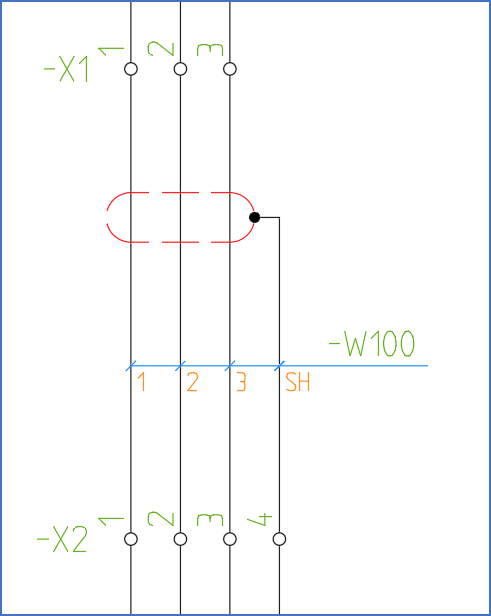|
<< Click to Display Table of Contents >> Shield |
  
|
|
<< Click to Display Table of Contents >> Shield |
  
|
The Shield command is used to draw shield symbols. It is found in the Symbol Insert Tool in the b - Cables resource category.
You use this command to draw a nice and proper shield symbol around a few lines. The shield symbol is only cosmetic. It will in no way influence the wire or the cable lists. The shield symbol will be placed in the Shield layer, which is not electrical and coloured red.
The Shield command is simple to use. You select the first and the last line, in the same way as when inserting terminals, and then the shield symbol is ready. In the same way as for several other macros, it will be enough to click in front of the first and behind the last line.
If you want to include a shield in a cable core list, it is easy to accomplish that, even though the Shield symbol is cosmetic only. The shield will be treated as a cable core. Indeed, it is common practice to connect the shield in only one end of a cable, and that will not create any problem in cadett ELSA, which allows cable cores to hang loose in one end or the other, in both ends or not at all.

Figure 823: A preferred way of drawing a shielded cable
The figure above shows how this can be done.
You insert a Shield symbol that surrounds the conventional cable cores, which clearly shows that this is a shielded cable. You then draw a line from the shield symbol to the terminal that the shield is connected to. A connection point (a Donut) is used as a further clarification where the line meets the shield symbol. Finally, a cable symbol is used to define both the conventional cable cores and the shield as cable cores. Specify a suitable core number for the shield, for instance SH, SHIELD or something similar.
Connection-wise, the line that meets the shield symbol will be seen as hanging loose in that end, which means that it will not be connected to anything in that end, which was exactly what you wanted to accomplish!
–W100:SH will in this example be connected to –X2:4 in one end and not connected at all in the other.
Cable |
Core |
From |
To |
|---|---|---|---|
–W100 |
1 |
–X2:1 |
–X1:1 |
|
2 |
–X2:2 |
–X1:2 |
|
3 |
–X2:3 |
–X1:3 |
|
SH |
–X2:4 |
|
If you wish to connect the shield in both ends, you should continue the line from –X2:4 all the way to terminal group –X1 and connect it there. In that way, the shield will turn up in the cable core list connected in both ends, as wished.